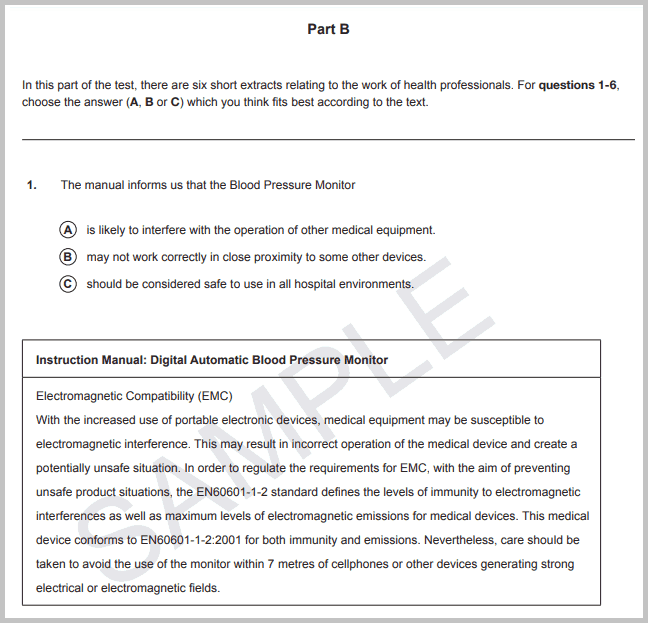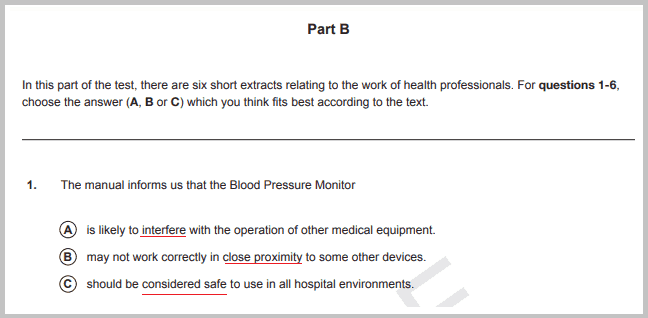Reading Part B is the second part of the OET 2.0 exam and many argue that it is more challenging than Par tA.
Here we discuss this test in detail and tips on how to achieve the most available marks.
What is Reading Part B?
This exam assesses your ability to identify the detail, the general idea or main point of six short texts sourced from the healthcare workplace (100-150 words each). The texts might consist of extracts from policy documents, hospital guidelines, manuals or internal communications, such as emails or memos. You must answer a total of 6 multiple-choice question (one per passage).
There are 6 marks available in Part B.
You can find more information about the OET 2.0 reading exam structure on the OET website.
The first thing to note from this is that: the type of passage you will read is the type of document you would find at work. It could be an email from your manager or a note from your college or instructions on how to work new hospital equipment.
The second thing to note is: you will read six different texts and answer one multiple choice question for each.
Below you can see an example of a Part B question.
Your job is to read each passage (just like these ones above) and to answer a multiple choice question based on what you have read.
So how do we work out our answer?
1. Carefully read the passage
Unlike in OET 2.0 Reading Part A where you should skim and scan the text, you should read the entire passage in Part B.
Start by reading the questions and highlighting all of the key words in the answers like this:
2. Try to define any unfamiliar words
Each question will likely have one or two words that you may be unfamiliar with.
In this case we have the examples: interfere and close proximity.
If you are unsure what they mean, try reading the paragraph to find more context. Let’s look at the three examples here.
A. Interfere – You may have heard this word which means to ‘stop something from happening’. You may have also noticed the word ‘interference’ in the first paragraph. Part B of the test may use paragraphing.
B. Close proximity – This word is a little bit more complex and means ‘a close distance’. You may read this answer as ‘…may not work correctly when close to some other devices’.
C. Considered – A more common vocabulary choice meaning ‘is believed to be’. In this case ‘…is believed to be safe’.
Once you have defined these unfamiliar words try looking for them or any synonyms in the passage.
3. Eliminate incorrect answers
Now you are required to choose which answers are NOT correct.
The passage is provided for you again below. Take a few moments to read through the passage in detail and try to find the keywords we have listed above.
Be careful of words such as ‘almost’, ‘unlikely’ ‘may not’ and ‘should’ as these can often change the meaning of a sentence. There is a big difference between ‘the equipment is almost safe’ and ‘the equipment is safe’.
A. Interfere – We can see in the first paragraph that it mentions ‘interference’ and says ‘medical equipment may be susceptible to electromagnetic interference.’ However, the question says ‘is likely to interfere’. This is a trick answer as there is a difference between ‘may be’ and ‘likely to’.
B. Close proximity – We know that ‘close proximity’ means ‘close to’. There is no mention of ‘close to’ but it does mention ‘within 7 metres’ near the end of the paragraph.
C. Considered safe – There is mention around halfway down the paragraph of ‘preventing unsafe product situations’. However, this is nothing that mentions whether it should be considered safe in all hospital environments.
4. Choose the correct answer
Finally, we need to choose the correct answer based on the information we have.
The correct answer in this question is B: may not work correctly in close proximity to some other devices.
We can see this in the following sentence:
Nevertheless, care should be taken to avoid the use of the monitor within 7 metres of cellphones or other devices generating strong electrical or electromagnetic fields.
The later parts of the reading exam can be some of the most difficult and challenging parts of the entire OET exam.
The important advice we give to all of our students is:
- Practice. The more tests you complete the better you will be at answering this type of question.
- Review your answers. Once you have completed a practice test, take some time to go back and review your answers.
- The passing score for the entire exam is 30/42 however only 6 of these marks are available in Part B.
How are you finding the new Reading Exam Part B?
We’d love to hear from you. Feel free to ask us any questions you might have in the comments below and our teachers will get back to you.


